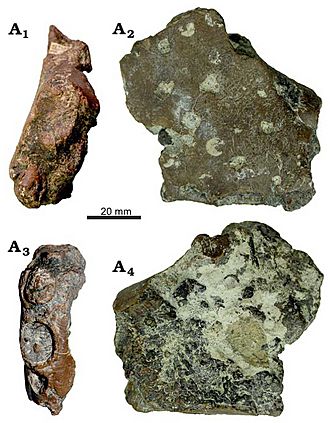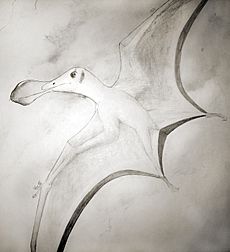Nicorhynchus facts for kids
Quick facts for kids Nicorhynchus |
|
|---|---|
 |
|
| Holotype jaw fragment of N. capito in multiple views | |
| Scientific classification |
|
| Kingdom: | Animalia |
| Phylum: | Chordata |
| Order: | †Pterosauria |
| Suborder: | †Pterodactyloidea |
| Clade: | †Ornithocheirae |
| Family: | †Ornithocheiridae |
| Subfamily: | †Coloborhynchinae |
| Genus: | †Nicorhynchus Holgado & Pêgas, 2020 |
| Type species | |
| †Ornithocheirus capito Seeley, 1870
|
|
| Species | |
|
|
Nicorhynchus was a type of flying reptile called a pterosaur. It lived a very long time ago, between 105 and 92.5 million years ago. This was during the Cretaceous Period, a time when dinosaurs roamed the Earth! Its name, Nicorhynchus, means "knucker snout." A "knucker" is a kind of water dragon from old English stories. Scientists have found fossils of Nicorhynchus in both England and Morocco.
Contents
Meet Nicorhynchus
Nicorhynchus was a large pterosaur, which means "winged lizard." Pterosaurs were not dinosaurs, but they lived at the same time. They were the first vertebrates (animals with backbones) to evolve powered flight. Nicorhynchus likely soared over ancient seas, hunting for fish.
What Did Nicorhynchus Look Like?
Like other pterosaurs, Nicorhynchus had wings made of skin and muscle. These wings stretched from its long fourth finger to its ankles. It probably had a long, pointed snout, which is why its name includes "snout." Its teeth were likely sharp, perfect for catching slippery prey.
Where Did Nicorhynchus Live?
Fossils of Nicorhynchus have been found in two different places. One species, N. capito, was discovered in England. Another species, N. fluviferox, was found in Morocco, North Africa. This shows that these amazing flying reptiles lived across wide areas. They likely lived near ancient coastlines or large bodies of water.
How Was Nicorhynchus Discovered?
The first species, N. capito, was originally named Ornithocheirus capito in 1870. Later, in 2019, another species was found and named Coloborhynchus fluviferox. Scientists often re-examine old fossils and new discoveries. In 2020, researchers decided that both of these species actually belonged to a new group, which they named Nicorhynchus. This is how science learns more about ancient life!
Images for kids
See also
 In Spanish: Nicorhynchus para niños
In Spanish: Nicorhynchus para niños


